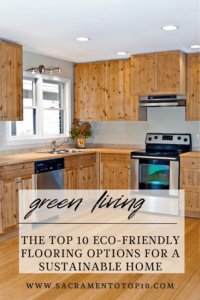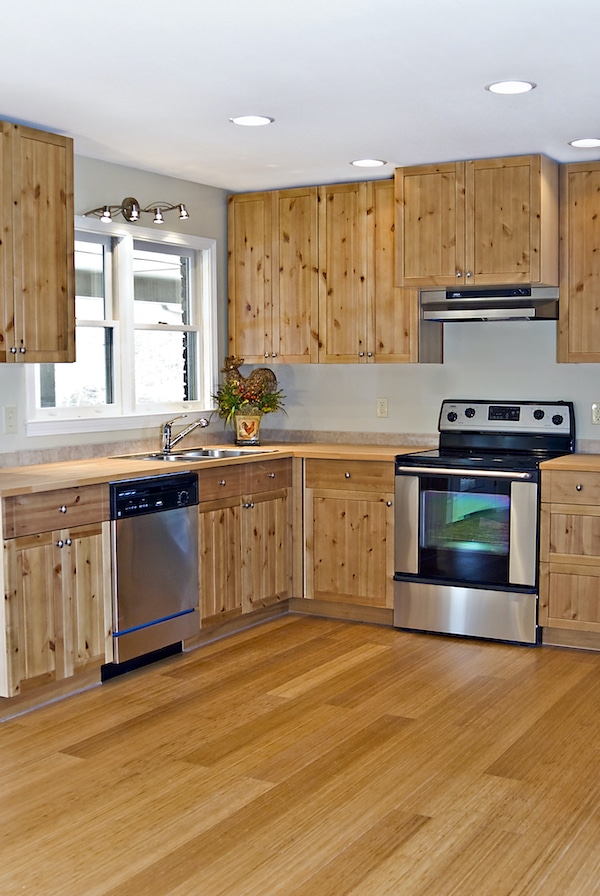As awareness about the environmental impact of our choices increases, more and more people are looking for eco-friendly options for their homes. One area that has seen a surge in demand for eco-friendly alternatives is flooring. From bamboo to cork, there are a plethora of sustainable flooring options available in the market today. In this article, we will discuss the top 10 eco-friendly flooring options for a sustainable home.
1. Bamboo Flooring
Bamboo is a fast-growing grass that can be harvested every 3-5 years, making it an environmentally sustainable material. The manufacturing process for bamboo flooring involves slicing the bamboo into thin strips, boiling and treating them, and then gluing them together. The result is a durable and attractive flooring option that can be finished with various stains and sealers to achieve different looks. Bamboo flooring is also easy to maintain, requiring only regular sweeping and occasional mopping.
 Bamboo flooring is a popular and eco-friendly flooring option that provides many benefits for homeowners. Here are some tips to help you get the most out of your bamboo flooring:
Bamboo flooring is a popular and eco-friendly flooring option that provides many benefits for homeowners. Here are some tips to help you get the most out of your bamboo flooring:
- Choose high-quality bamboo flooring: The quality of bamboo flooring can vary widely, so it’s important to choose a reputable brand that uses high-quality bamboo and manufacturing processes.
- Acclimate the flooring: Before installation, allow the bamboo flooring to acclimate to the room’s temperature and humidity for at least 72 hours. This will help prevent warping or shrinking after installation.
- Keep the flooring clean: Bamboo flooring should be swept or vacuumed regularly to remove dirt and debris. Avoid using harsh chemicals or abrasive cleaners that can damage the flooring.
- Use rugs and mats: To prevent scratches or wear, use area rugs and mats in high-traffic areas or under furniture.
- Protect against moisture: Bamboo flooring is sensitive to moisture, so it’s important to clean up spills immediately and avoid mopping with excessive water. Use a damp mop or cleaning cloth to clean the flooring.
- Refinish when needed: Over time, bamboo flooring can become scratched or dull. Refinishing can restore the flooring’s original shine and durability. Be sure to use a professional flooring contractor to ensure proper refinishing.
2. Cork Flooring
Cork is harvested from the bark of cork oak trees, which regenerate their bark every 9-12 years. Cork flooring is a renewable, biodegradable, and recyclable material that offers several benefits. It is naturally insulating, making it a great choice for cold climates, and it absorbs sound, making it a good option for apartments or other shared living spaces. Cork flooring is also resistant to water and mildew, making it suitable for use in bathrooms or other damp areas.
When looking for high-quality cork flooring, there are several factors to consider. Here are some things to look for:
- Density: The density of cork flooring is an important factor to consider as it affects the durability and comfort of the flooring. Higher density cork flooring is more durable and resistant to wear and tear.
- Thickness: The thickness of cork flooring is another important factor to consider as it affects the insulation and sound-absorbing properties of the flooring. Thicker cork flooring provides better insulation and sound absorption.
- Finish: High-quality cork flooring should have a high-quality finish that is resistant to scratches, stains, and wear. It should also be easy to maintain and clean.
- Manufacturing process: Look for cork flooring that is produced using sustainable manufacturing processes that minimize waste and environmental impact.
- Warranty: Choose a cork flooring brand that offers a warranty or guarantee to ensure the quality and durability of the product.
- Installation: Choose cork flooring that is easy to install and does not require special tools or skills. Look for cork flooring that can be installed using a click-lock system or glue-down method.
- Brand reputation: Look for cork flooring brands that have a good reputation for quality and customer service. Research the brand and read customer reviews to get an idea of the product’s quality and durability.
3. Linoleum Flooring
Linoleum is a type of flooring made from natural materials like linseed oil, wood flour, and pine rosin. It is a sustainable material that is both biodegradable and recyclable, and it offers several advantages over other flooring options. Linoleum is naturally antimicrobial, meaning it resists the growth of bacteria and fungi, making it a great choice for those with allergies or respiratory issues. It is also fire-resistant and has a long lifespan, with some linoleum floors lasting up to 40 years.
What we called linoleum while I was growing up was actually vinyl. Linoleum is way cooler.
Besides being an eco-friendly flooring option, Linoleum offers a range of fantastic design possibilities. Here are some special designs that can be created with linoleum floors:
- Geometric patterns: Linoleum flooring can be cut into various shapes and sizes to create geometric patterns such as hexagons, triangles, or diamonds. This is a great way to add visual interest to your flooring and create a unique look.
- Borders and inlays: Linoleum flooring can be used to create borders or inlays that add contrast and texture to the flooring. This is a great way to define a space or add a decorative touch to your flooring.
- Checkerboard pattern: A checkerboard pattern is a classic design that can be created with linoleum flooring. This design involves alternating tiles in two different colors to create a checkerboard effect. This is a great option for kitchens or bathrooms and can be customized to fit any color scheme.
- Mosaic patterns: Linoleum flooring can be cut into small pieces and arranged to create mosaic patterns that add texture and depth to your flooring. This is a great option for entryways or other high-traffic areas.
- Color blocking: Linoleum flooring is available in a wide range of colors, making it easy to create a color blocking effect. This involves using two or more colors of linoleum to create a bold and modern look.
- Printed designs: Linoleum flooring can be printed with a variety of designs, including floral patterns, geometric designs, and more. This is a great way to add a unique and personalized touch to your flooring.
By considering these design possibilities, you can create a linoleum flooring that is not only eco-friendly but also visually stunning and personalized to your taste.
4. Reclaimed Hardwood Flooring
Reclaimed hardwood flooring is made from salvaged wood that is repurposed for use as flooring. This is an environmentally friendly option that reduces waste and can provide a unique look to your home. Reclaimed wood can come from a variety of sources, including old buildings, barns, and even wine barrels. The wood is cleaned, sanded, and refinished to create a beautiful and durable flooring option.
Locating materials for reclaimed wood floors can be a bit of a challenge, but there are several ways to find them. Here are some tips to help you locate materials for reclaimed wood floors:
- Salvage yards and building material suppliers: Salvage yards and building material suppliers often have a wide variety of reclaimed wood available for purchase. These businesses specialize in salvaging materials from old buildings, barns, and other structures, and can be a great source for high-quality reclaimed wood.
- Online marketplaces: Online marketplaces such as Craigslist and Facebook Marketplace can be a good source for reclaimed wood. You can search for sellers in your area and browse their listings to find the type of wood you’re looking for.
- Demolition companies: Demolition companies often have access to large quantities of reclaimed wood from buildings that are being torn down. You can contact local demolition companies and inquire about purchasing reclaimed wood from their projects.
- Woodworkers and carpenters: Woodworkers and carpenters often have access to reclaimed wood and may be willing to sell or trade it. You can contact local woodworkers and carpenters and inquire about their sources for reclaimed wood.
- Freecycle groups: Freecycle groups are online communities where members can give away or trade items for free. You can search for local Freecycle groups and post a request for reclaimed wood.
5. Recycled Metal Flooring
Recycled metal flooring is made from salvaged metal, including aluminum, steel, and copper. This is a sustainable option that can provide a modern and industrial look to your home. Metal flooring is highly durable, resistant to wear and tear, and easy to maintain. It is also a good option for those with allergies or respiratory issues since it does not harbor dust or allergens.
Recycled metal flooring is a sustainable and durable flooring option that provides many benefits for homeowners. However, as with any flooring option, there are both pros and cons to consider. Here are some of the pros and cons of recycled metal flooring:
Pros:
- Sustainability: Recycled metal flooring is a sustainable option that helps to reduce waste and preserve natural resources. Using recycled metal reduces the need for mining new metals, which can have a significant environmental impact.
- Durability: Metal flooring is highly durable and resistant to wear and tear, making it a great choice for high-traffic areas. It is also resistant to water and fire, providing additional safety benefits.
- Low maintenance: Metal flooring is easy to clean and maintain, requiring only regular sweeping or vacuuming and occasional mopping with a mild cleaner.
- Style options: Recycled metal flooring can provide a modern and industrial look to your home. It is available in a variety of colors and finishes, including matte, shiny, and textured options.
- Hypoallergenic: Metal flooring is hypoallergenic and does not trap allergens like dust and pet dander, making it a good choice for those with allergies or respiratory issues.
Cons:
- Noise: Metal flooring can be noisy, especially in areas with high foot traffic. Adding rugs or mats can help to reduce noise levels and create a more comfortable environment.
- Cost: Recycled metal flooring can be more expensive than other flooring options due to its durability and sustainability.
- Installation: Metal flooring can be difficult to install and may require professional installation, especially for larger areas or complex designs.
- Cold: Metal flooring can be cold to the touch, especially in colder climates. It is important to consider adding radiant heating or area rugs to provide additional warmth.
- Maintenance: While metal flooring is low maintenance, it can be susceptible to scratching and denting. It is important to avoid dragging heavy furniture or objects across the flooring and to immediately clean up spills or stains to prevent damage.
By considering these pros and cons, you can determine if recycled metal flooring is the right choice for your home. With its sustainability, durability, and modern style options, recycled metal flooring can provide a unique and eco-friendly addition to your home.
6. Wool Carpeting
Wool carpeting is a natural and sustainable option that is soft, comfortable, and luxurious underfoot. Plus,it’s an excellent eco-friendly choice for several reasons. Here are some of the benefits of choosing wool carpeting:
- Sustainable: Wool is a renewable resource that can be shorn from sheep every year without harming the animal. This makes wool carpeting a sustainable choice for flooring.
- Biodegradable: Wool is biodegradable, which means that it can be broken down by natural processes after it is discarded. This reduces waste and environmental impact.
- Energy efficient: Wool is a natural insulator that can help to regulate temperature and reduce energy usage. Wool carpeting can help to keep a room warm in the winter and cool in the summer, reducing the need for heating and cooling systems.
- Air quality: Wool carpeting is a natural material that does not emit harmful chemicals or volatile organic compounds (VOCs) like synthetic materials. This means that it can help to improve indoor air quality.
- Durability: Wool carpeting is highly durable and can last for many years with proper care and maintenance. This reduces the need for replacement and further reduces environmental impact.
- Style options: Wool carpeting is available in a variety of colors, textures, and patterns, making it a versatile option for any home décor.
By choosing wool carpeting, you can enjoy a sustainable, durable, and stylish flooring option that is also good for the environment.
7. Natural Stone Flooring
Natural stone flooring is a durable and long-lasting option that can add elegance and beauty to your home. Stone flooring is available in a variety of materials, including granite, marble, limestone, and slate.
When choosing natural stone for flooring in your home, it’s important to consider the characteristics of each type of stone and how they will fit your specific needs. Here are some of the most popular types of natural stone for flooring and their characteristics:
- Marble: Marble is a popular choice for flooring due to its elegant and luxurious appearance. It is available in a range of colors and veining patterns, but it can be prone to scratches and stains, so it may not be the best choice for high-traffic areas.
- Granite: Granite is a highly durable and resistant stone that can withstand heavy foot traffic and is easy to maintain. It is available in a range of colors and patterns, but it can be more expensive than other types of natural stone.
- Limestone: Limestone is a softer and more porous stone that can be prone to scratches and staining. It is available in a range of colors and textures and is a good choice for low-traffic areas.
- Slate: Slate is a durable and slip-resistant stone that is ideal for high-traffic areas. It is available in a range of colors and textures, and its natural cleft surface provides a rustic appearance.
- Travertine: Travertine is a porous and textured stone that is available in a range of warm earthy tones. It is a good choice for low-traffic areas and is a popular option for outdoor flooring.
- Sandstone: Sandstone is a durable and weather-resistant stone that is available in a range of colors and textures. It is a popular choice for outdoor flooring due to its natural look and durability.
8. Glass Tile Flooring
Glass tile flooring is a modern and stylish option that can be used to create a unique and customized look in your home. Glass tiles are made from recycled glass, making them an eco-friendly choice. They are also highly durable and resistant to scratches, stains, and water damage.
Here are some of the pros and cons of using glass tile flooring:
Pros:
- Aesthetics: Glass tile flooring can add a unique and modern look to your home. It is available in a variety of colors and patterns, allowing you to create a custom design for your home.
- Durability: Glass tile is highly durable and resistant to scratches, stains, and water damage. It is a great option for high-traffic areas such as entryways and kitchens.
- Easy to clean: Glass tile flooring is easy to clean and maintain. It can be wiped down with a damp cloth or mop and does not require harsh chemicals or cleaners.
- Environmentally friendly: Glass tile is a sustainable option, as it can be made from recycled glass. This reduces waste and helps to preserve natural resources.
Cons:
- Slipperiness: Glass tile can be slippery when wet, which can be dangerous in high-traffic areas or in areas prone to moisture such as bathrooms and kitchens.
- Cost: Glass tile can be more expensive than other flooring options due to its unique design and durability.
- Installation: Glass tile can be difficult to install, requiring professional installation for best results. Improper installation can result in cracking or uneven flooring.
- Coldness: Glass tile can be cold to the touch, especially in colder climates. This may make it uncomfortable to walk on or stand on for long periods of time.
By considering these pros and cons, you can determine if glass tile flooring is the right choice for your home. With its durability, sustainability, and modern style options, glass tile flooring can provide a unique and visually stunning addition to your home décor.
9. Terrazzo Flooring
If you’re looking for eco-friendly flooring yet want to maintain an old world style, Terrazzo flooring has been in existence for centuries. It originated in Italy during the 15th century, when workers in Venetian construction sites would collect discarded marble chips and use them to create a low-cost flooring option. The marble chips were mixed with clay and compressed to create a durable and visually striking surface.
Over time, the technique of creating terrazzo flooring evolved, with the addition of glass, metal, and other materials to create intricate and colorful designs. Terrazzo flooring became popular throughout Europe and was later introduced to the United States in the late 1800s.
During the mid-20th century, terrazzo flooring experienced a resurgence in popularity, particularly in commercial and institutional settings. Today, terrazzo flooring remains a popular and durable flooring option, with modern advances in technology and design allowing for even more intricate and customizable designs.
10. Rubber Flooring
Rubber flooring is a sustainable and durable option that can be used in a variety of settings. It is
a great option for your home for several reasons:
- Durability: Rubber flooring is highly durable and resistant to wear and tear, making it a great choice for high-traffic areas such as entryways, kitchens, and playrooms.
- Safety: Rubber flooring is slip-resistant, which can reduce the risk of slips and falls, especially in areas prone to moisture.
- Sound absorption: Rubber flooring can help to absorb sound, making it a good option for homes with open floor plans or high ceilings.
- Comfort: Rubber flooring is soft and comfortable to walk on, making it a good option for areas where you spend a lot of time standing or walking.
- Eco-friendly: Rubber flooring can be made from recycled rubber, making it a sustainable and environmentally-friendly option.
- Easy to clean: Rubber flooring is easy to clean and maintain, requiring only a damp mop or cloth to keep it looking its best.
- Style options: Rubber flooring is available in a variety of colors and textures, allowing you to create a custom look that complements your home décor.
FAQ – Frequently Asked Question
Eco-Friendly
Not necessarily. While some eco-friendly flooring options may be more expensive, others are affordable and budget-friendly.
Yes, bamboo flooring is just as durable as hardwood flooring and can last for many years with proper maintenance.
Yes, natural stone flooring is durable and can withstand high traffic areas.
Rubber flooring is suitable for most homes, but it is best suited for homes with a modern or industrial aesthetic.
Cork flooring is not waterproof, but it is water-resistant and can withstand spills and moisture.
In addition to these eco-friendly flooring options, there are also some important factors to consider when choosing flooring for your sustainable home. One important consideration is the installation process, as some flooring options may require more resources or produce more waste than others. It is also important to choose flooring that is durable and long-lasting, as this will reduce the need for replacement and reduce waste over time.
Another factor to consider is the overall impact of the flooring on the environment, including its manufacturing process and transportation. It is important to choose flooring options that are produced using sustainable practices and materials and that have a minimal impact on the environment.
There are many eco-friendly flooring options available that can provide both sustainability and style to your home. From bamboo to cork, natural stone to recycled metal, there are many choices to fit your design preferences and environmental concerns. By considering the durability, manufacturing process, and overall impact on the environment, you can choose the best flooring option for your sustainable home.




